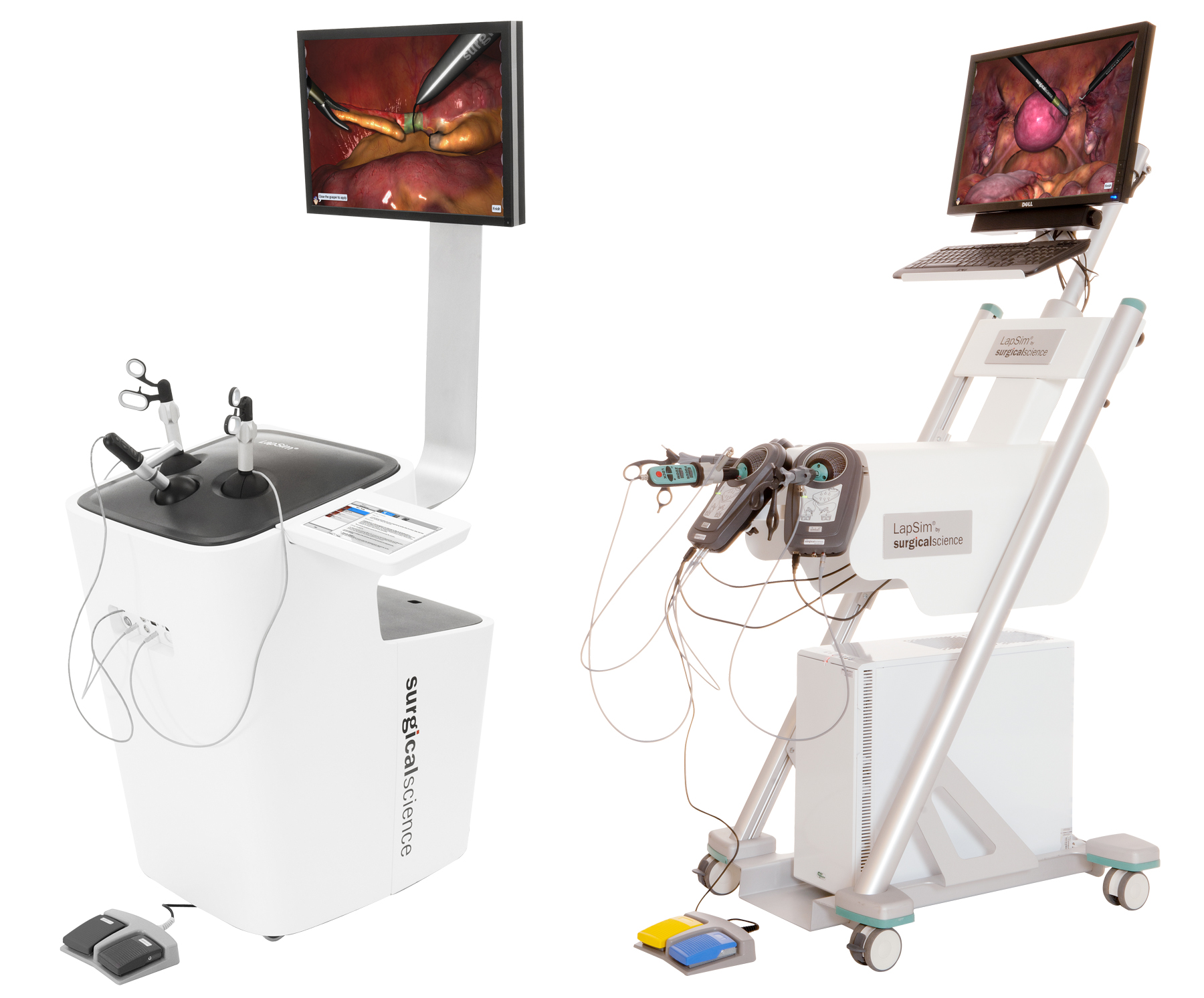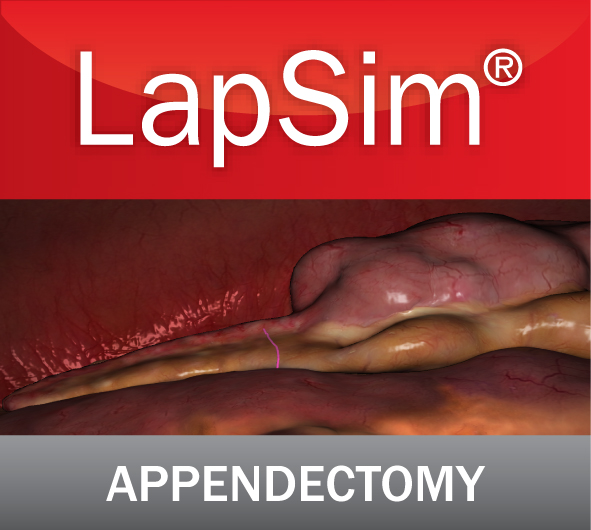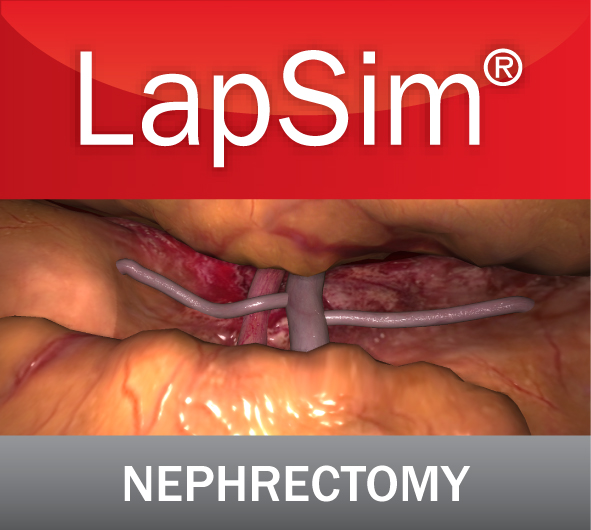- Haptic System – All necessary computer and monitor hardware on a height adjustable rolling SimFrame; includes LapSim core software modules.
-
Non-Haptic System- All necessary computer and monitor hardware on a height adjustable rolling SimStation; includes LapSim core software modules.
- Portability Package – Wheeled for convenience (airplane carry-on compatible), the case can be used to set the laptop on for better viewing during use; and has the ability to be utilized in team training with existing OR equipment.
- Basic Skills
- Camera navigation
- Instrument navigation
- Coordination
- Grasping
- Cutting
- Clip applying
- Lifting and grasping
- Suturing
- Precision and speed
- Handling intestines
- Fine dissection
- Seal and Cut
- Catheter Insertion
- Task Training
Inspired by the Fundamentals of Laparoscopic Surgery (FLS), a standard developed by the Society of American Gastrointestinal Endoscopic Surgeons (SAGES), the Task Training module includes four exercises:
- Peg Transfer
- Pattern Cutting
- Ligating Loop
- Intra-corporeal Knot Tying
- Camera Anatomy Training
- Abdominal anatomy
- Female pelvic anatomy
- Additional modules are under development
- Appendectomy
The Appendectomy Module is designed to introduce residents to one of the most frequently performed surgeries in hospital ORs. This scenario-based simulation module will continually challenge trainees’ procedural knowledge and decision-making skills with extensive pathology variations and complications.
- Loop technique
- Single stapling technique
- Dual stapling technique
- Optional stapling technique
- Bariatrics
The LapSim Bariatrics Module features procedural deconstruction capabilities simulating various bariatric training tasks.
- Running the bowel
- Measure the bowel
- Lap-band suturing
- Jejunojejunal anastomosis
- Cholecystectomy
- Gynecology
In study after study, training on LapSim’s Gynecology Module has been proven to provide significant improvement in trainees’ skills before they step foot in an operating room.
- Tubal occlusion
- Salpingectomy
- Salpingostomy
- Myoma suturing
- Hysterectomy
Simulating the critical steps of a laparoscopic hysterectomy procedure, the LapSim Hysterectomy Module offers a comprehensive and customizable virtual training experience. With the integrated SimPraxis component, trainees must demonstrate both critical knowledge and hands-on proficiency.
- Right & left uterine artery dissection
- Vaginal cuff opening
- Suturing of the cuff after removal of the uterus
- Nephrectomy
The LapSim Nephrectomy Module features procedural deconstruction capabilities simulating the surgical removal of the kidney.
- Kidney clips
- Kidney dissection
- Camera Management Exercise
- Suturing & Anastomosis
Building on the foundational elements of LapSim Basic Skills, the Suturing & Anastomosis Module challenges learners with a progressively complex, stepwise approach to suturing and knot tying techniques.
- Needle passing
- Interrupted stitching
- Running stitching
- Square knot
- Surgeon’s knot
- Stitch & square knot
- Stitch & surgeon’s knot
- Interrupted suturing
- Running suturing
- Side-to-side anastomosis
- VATS Lobectomy
- Dissection of hilum/vessels
- Identification of vessels
- Use of elastic vessel rubber loop
- Sequential stapling of veins, arteries, bronchus and fissure
- Bleeding control
- Avoid critical structures, ex. the Phrenic nerve
Laparoscopic Skills:
-
Basic Skills
- Camera navigation
- Instrument navigation
- Coordination
- Grasping
- Cutting
- Clip applying
- Lifting and grasping
- Suturing
- Precision and speed
- Handling intestines
- Fine dissection
- Seal and Cut
- Catheter Insertion
-
Task Training
- Peg Transfer
- Pattern Cutting
- Ligating Loop
- Intra-corporeal Knot Tyin
-
Camera Anatomy Training
- Abdominal anatomy
- Female pelvic anatomy
-
Appendectomy
- Loop technique
- Single stapling technique
- Dual stapling technique
- Optional stapling technique
-
Bariatrics
- Running the bowel
- Measure the bowel
- Lap-band suturing
- Jejunojejunal anastomosis
-
Cholecystectomy
- Clipping the cystic ductr
- Removing the gall bladder
-
Gynecology
- Tubal occlusion
- Salpingectomy
- Salpingostomy
- Myoma suturing
-
Hysterectomy
- Right & left uterine artery dissection
- Vaginal cuff opening
- Suturing of the cuff after removal of the uterus
-
Nephrectomy
- Kidney clips
- Kidney dissection
- Camera Management Exercise
-
Suturing & Anastomosis
- Needle passing
- Interrupted stitching
- Running stitching
- Square knot
- Surgeon’s knot
- Stitch & square knot
- Stitch & surgeon’s knot
- Interrupted suturing
- Running suturing
- Side-to-side anastomosis
-
VATS Lobectomy
- Dissection of hilum/vessels
- Identification of vessels
- Use of elastic vessel rubber loop
- Sequential stapling of veins, arteries, bronchus and fissure
- Bleeding control











